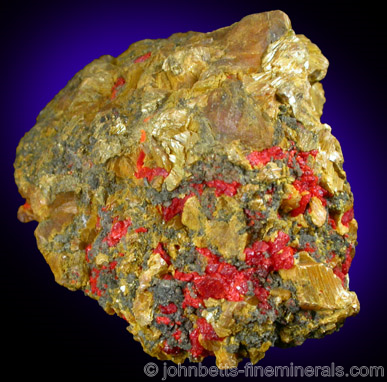The Mineral orpiment

Orpiment is known for its strikingly bright yellow color, though it can also be bright orange or lustrous brown. The name Orpiment is derived from the Latin Auripigmentum,
meaning gold pigment, in reference to its color and historical
use as a golden-yellow pigment. Orpiment is often associated with bright
red Realgar, and may form in strikingly colored and unique mineral
combinations.
Orpiment is a photosensitive mineral and will eventually dull and develop a white powdery film upon prolonged exposure to light. Due to the instability of Orpiment, specimens should be stored enclosed
and covered to prevent their exposure to light. Occasional exposure to
look at a specimen will not cause damage; only prolonged or repeated
exposure will cause deterioration.
Orpiment contains a significant amount of poisonous arsenic, and is
itself somewhat toxic. Washing hands is recommended after handling Orpiment specimens, especially if powdery.
Color
Bright yellow, orange-yellow, orange, orange-red, and brown
Crystal System
Monoclinic
Properties
Streak
Yellow |
Hardness
1.5 - 2 |
Transparency
Transparent to opaque |
Specific Gravity
3.4 - 3.5 |
Luster
Resinous to pearly. |
Cleavage
1,1 |
Fracture
Uneven |
Tenacity
Sectile and slightly flexible in thin flakes. |
Uses
Orpiment is an ore of arsenic. It was historically used as a yellow pigment and an ancient decorative stone.
Noteworthy Localities
Relatively large and gemmy butterscotch Orpiment crystals come from the Jiepaiyu (Shimen) Mine, Hunan Province, China; and outstanding bright spiky crystal plates and drusy crystals from the El'brusskiy mine, near Mt. Elbrus, Russia. Good quality specimens have also come from the Zareh Shuran Mine, Takab, Iran; Allchar, Roszdan, Macedonia; and Lucéram, Alpes-Maritimes, France. Some of the best examples of Orpiment have come from Peru in Quiruvilca, La Libertad, in the form of bright gemmy orange-brown crystals. Also in Peru is the Palomo Mine, Huancavelica, which produced rounded, ball-like aggregates of this mineral.
In the U.S., a relatively new locality has produced some of the finest Orpiment specimens. This locality is the Twin Creeks Mine, Potosi District, Humboldt Co., Nevada, famous for its transparent butterscotch crystal groups.
Bright yellow foliated Orpiment almost invariably associated with splotches of Realgar comes from Nevada at the Getchell Mine, Humboldt Co.; and from the White Cap Mine, Manhattan, Nye Co. Bright Orpiment crystals on a contrasting white Calcite matrix come from Mercur, Tooele Co, Utah.
Distingushing Similar Minerals
Pararealgar - Occurs as a replacement of Realgar crystals; otherwise difficult to distinguish.
Sulfur - Lacks cleavage and has distinct odor.
Autunite - Forms in different crystal and environments, and often has a greenish tinge which is lacking in Orpiment.